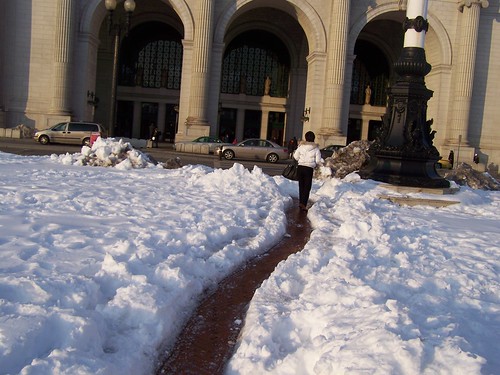More on Union Station DC and the need for innovative master planning

Flickr photo by Bencito the Traveller.
As mentioned in a blog post over the weekend, Union Station has committed to integrating inter-city bus services into the station, something that has been discussed for 20+ years...
Delegate Eleanor Holmes Norton sent out a press release about this, "Intercity Bus Service at Union Station to Begin After Years of Norton Hearings and Persistence." From the release:
Norton, who has pressed for years for intercity bus service at Union Station, chaired the first hearings in recent memory on Union Station after she became chair of the Subcommittee on Economic Development, Public Buildings and Emergency Management, and began a sustained effort to bring intercity bus service to Union Station.
In response to pressure from Norton’s subcommittee and from the bipartisan leadership of the House Transportation and Infrastructure Committee, USRC initially moved forward only with a pilot intercity bus service program in January 2010, but Norton continued to insist on permanent service, in keeping with the congressional mandate to make Union Station a fully intermodal facility. Norton finally asked the USRC chair, Deputy Secretary of Transportation John Porcari, to become active in negotiations with intercity bus carriers in order to get permanent intercity bus service at Union Station.
Norton said, “Union Station is behind other big cities in promoting fully intermodal travel, but today’s economy, environmental necessity and public demand for inexpensive travel have now made intercity bus service a public necessity.” Norton continues to take a strong interest in Union Station, demanding a master plan for the station and, just last week, introducing a bill to require the first annual public audit of USRC.
I guess a big problem with Union Station is that the "public"-private partnership agreement that was created for the building's rehabilitation and resuscitation is probably pretty one sided, which shouldn't be a surprise given that the agreement was made in the mid-1980s. The Union Station Redevelopment Corporation has always been pretty insulated.
But it's exciting (although I won't hold my breath in terms of expecting a super creative and innovative approach) to see that Delegate Norton is arguing that there needs to be a master plan for Union Station.
It needs to cover the station in terms of at least three functions:
1. Its role as a primary gateway to Washington, DC, and as a key entry point for visitors;
2. Its role as an intermodal transportation center, not just for visitors, but for residents and workers as well;
3. Its role as a place to shop, since a big part of its revenue stream comes from the retail operations there.
A master plan should cover these issues creatively and comprehensively.
For example, I argue that Union Station is a key place to interpret transit and explain how to use it (transit wayfinding). See "Union Station Intermodal Transportation Meeting" (2008) and "Public meeting on DC) Union Station Intermodal Transit Center Feasibility Study" (2009).
Union Station ought to be one of the locations for a major visitor center. (More on this in a couple weeks.)
It ought to have retail plan that prioritizes the city and local business. Instead, it focuses more and more on chain development and seeks tax breaks to do it. See "Tax Breaks, Developers, etc., and Union Station" and "Interesting Union Station Business Story."
It ought to have a cultural interpretation program that explains the building and its history and the history of railroad transportation.
You'd think that the Union Station Revitalization Corporation would care enough about the quality of the visitor experience to have developed sometime within the last 25 years a memorandum of understanding with the National Park Service covering snow removal from Union Station Plaza.
Labels: commercial district revitalization planning, transit and economic development, transit wayfinding, transportation planning, urban design/placemaking, visitor services




0 Comments:
Post a Comment
<< Home